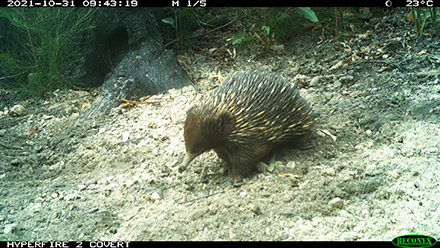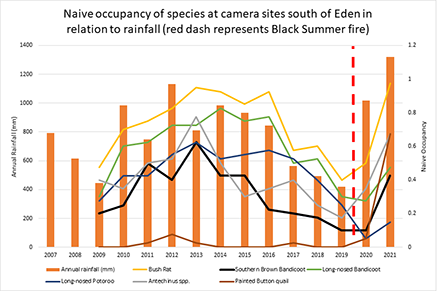Small native mammals including bandicoots, antechinus and Bush Rats are showing remarkable recovery two years on from the Black Summer fires, long-term camera monitoring in State forests south of Eden shows. Source: Timberbiz
Forestry Corporation of NSW Senior Field Ecologist Rohan Bilney said Forestry Corporation of NSW has been monitoring wildlife at 40 sites in State forests south of Eden since 2007 as part of the Southern Brown Bandicoot Species Management Plan, and every monitoring site was impacted by fires in 2019-20.
“The Black Summer fire and the severe drought that preceded it caused numerous small mammal species to decline, with some showing a greater than 50% decline, but within two years of the fire we’re delighted to see most species bouncing back, some rather dramatically,” Dr Bilney said.
“Conditions over the past two years have been ideal, as we’ve experienced increased rainfall and prolific vegetation regrowth providing ideal conditions for breeding and recovery for a range of animal species including Southern Brown Bandicoots, Long-nosed Bandicoots, Bush Rats and Agile Antechinus.
“In particular, populations of Southern Brown Bandicoots and Bush Rats have exploded, with our cameras recording the highest occupancy rates we’ve seen in 5-6 years, and approaching our highest ever detections.
“But the most remarkable change in occupancy has been with the Painted Button quail, a small bird species rarely detected pre-fire, being detected at over two-thirds of the monitoring sites last year. That equates to greater than a 10-fold increase in occupancy rate within a 12-month period.
“While the recovery of smaller native mammals has been most pronounced, larger and more common species including Common Wombats, brush-tailed possums, Swamp Wallabies, Lace Monitors, Short-beaked Echidnas and Superb Lyrebirds have continued to be recorded at rates similar to those recorded before the fires and drought.
“While this is preliminary monitoring data, our cameras have been monitoring the same 40 locations in State forests south of Eden for more than a decade and this latest data is a really promising sign that many native species have not only survived the Black Summer fires quite well but are currently thriving.”







